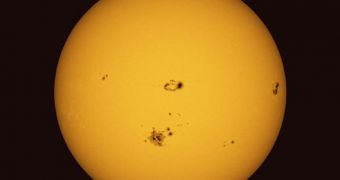A group of investigators at the Stanford University, in the United States, announces the development of a new early-warning method for detecting sunspots deep inside the Sun. The approach allows experts time to prepare for the potential effects of the ensuing solar storm.
Sunspots are dangerous because they can give birth to solar flares and coronal mass ejections (CME). In turn, these events release massive amounts of radiation and charged particles, which may be set on a collision course with our planet.
While it is true that Earth is protected by a magnetosphere that deflects the brunt of these emissions, sometimes the CME can be so massive that our defensive shield is overrun. Under such circumstances, knowing when the event will occur and how strong it will be is key.
The technique the Stanford team developed therefore also provides early-warning for solar flares as well. Its capabilities may augment those that NASA and other space agencies already have in place.
At this time, early-warning is achieved through a series of solar observatories, telescopes in orbit around Earth or the Sun itself that keep a constant eye on the star and its activity. Some of these instruments include SOHO, STEREO, SDO and so on.
What the Stanford group did was develop a way of identifying sunspots while they are still as much as 65,000 kilometers deep below the actual surface of the Sun. When set up, the detection method could provide us with 48 hours of advanced warning.
“Many solar physicists tried different ways to predict when sunspots would appear, but with no success,” Stanford physics professor Phil Scherrer explains. The new research effort was carried out in his laboratory. Stanford graduate student in physics Stathis Ilonidis was also a member of the team.
The latter managed to find a way of reducing clutter in data sent back to Earth by the Michelson Doppler Imager (MDI) instrument aboard the NASA Solar and Heliospheric Observatory (SOHO).
Data from the Helioseismic and Magnetic Imager (HMI) instrument on the space agency's Solar Dynamics Observatory (SDO) were also included in the study. The two instruments can detect sounds produced by developing sunspots deep within the Sun.
The new technique Ilonidis developed reduces the electronic clutter that permeates MDI and HMI data, essentially allowing experts to accurately measure solar sounds. Details of the technique were published in the August 19 issue of the top journal Science.
“We know enough about the structure of the Sun that we can predict the travel path and travel time of an acoustic wave as it propagates through the interior of the Sun,” Stanford Hansen Experimental Physics Lab senior research scientist Junwei Zhao adds.
“Travel times get perturbed if there are magnetic fields located along the wave's travel path,” he explains, saying that this is one of the main elements solar physicists use to predict the formation of a new solar flare.

 14 DAY TRIAL //
14 DAY TRIAL //